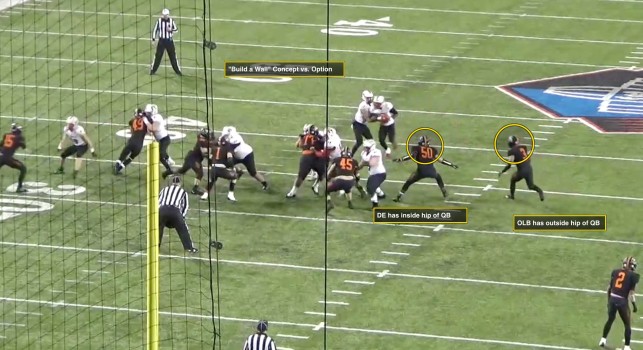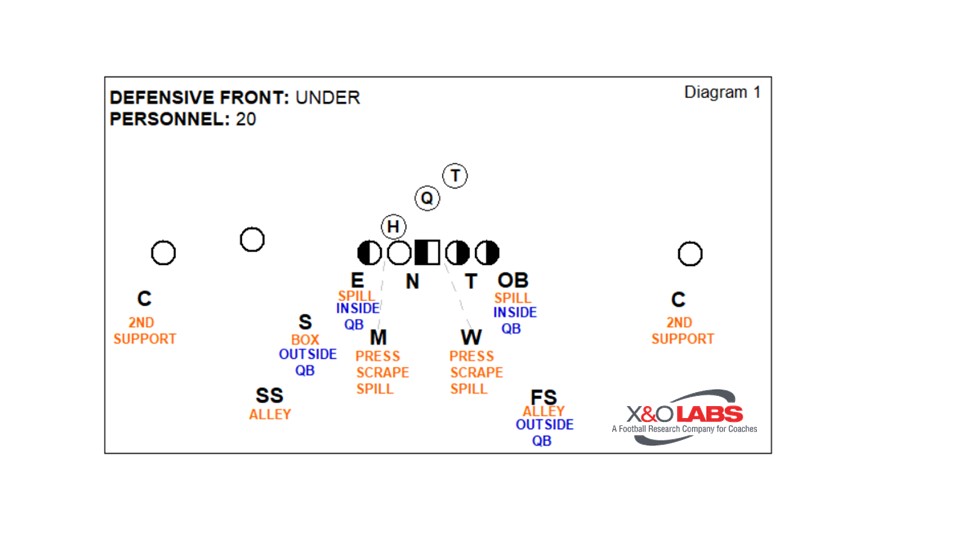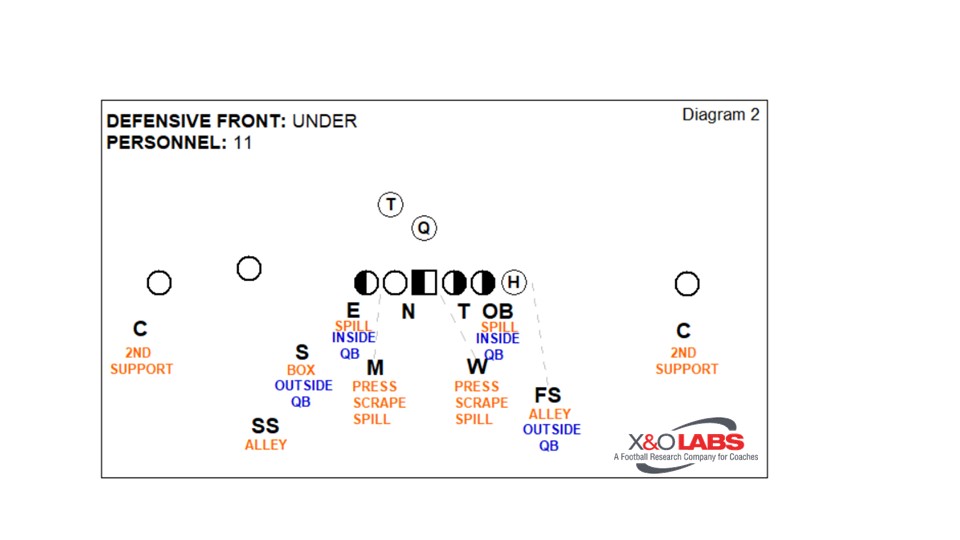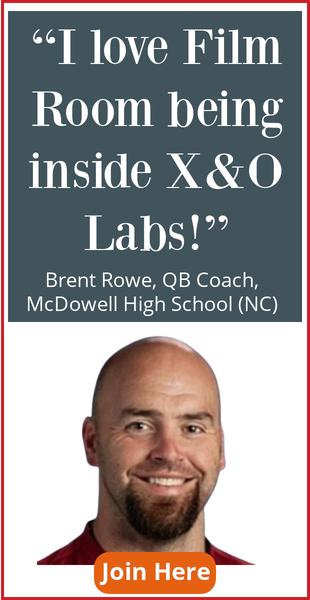By Spencer Leno
Co-Defensive Coordinator/ ILB Coach
Massillon Washington High School (OH)
Twitter: @SpencerLeno
More offenses are incorporating a hybrid fullback and tight-end type of player into their offensive scheme. With this hybrid player, teams can align in 11, 20, and sometimes even 10 personnel without subbing anyone in or out. As coordinators, it is harder to distinguish when an offense may align in a specific formation that correlates with the personnel grouping they have on the field. For this reason, our defense wants to have the ability to attack an offense using multiple fronts, while still maintaining our rules and fits.
One of Massillon's top defensive goals is to stop the run. We believe that if we can win the rushing war, we will win the game. We are a base 3-4 defense that can align in multiple fronts. Throughout a game, we will present both odd and even looks to an offense. Our defense also values the importance of using these multiple fronts while still being able to keep the same personnel on the field. It is crucial that when utilizing different looks, we can keep our reads and rules the same for every position. At Massillon, we are predominantly a spill defense, but depending on our game plan, we can box the ball inside as well. We ultimately want the ball to go lateral to allow our athletes to run to the ball and make tackles. We've taken on the mindset of "building a wall" and being gap sound in everything we do. Two of the fronts we utilize are our Under and Okie fronts.

Key Terms:
Our players and coaches all must use the same universal terms that apply to all of our position groups. The scheme must be simple along with our communication, reads, and fits. Before we drill any team sessions, we make sure that our position groups practice these techniques and aiming points throughout individual, half-line, and inside run. These terms can be applied to all of the fronts we use.
The main terms we use when introducing our run fits are below and will be explained throughout the article.
-Spill
-Press
-Secondary support (Corners)
-Box
-Cutback
-Inside point of QB
-Scrape
-Alley
-Outside point of QB
20/11 Personnel vs. Under
The use of an H forces the defense to account for an extra gap. As coordinators, we have to decide how we're going to attack and align with the extra gap. The extra gap can be created through the offensive play call or by their initial alignment. When the H is on the ball, a defense must decide on how to play the C gap based on what an offense wants to do. Since the H can move when he is aligned off the line of scrimmage, we want to be multiple in our fronts and alignments. We don't want to have too many checks and do not want a formation to dictate which front or coverage we run. This past season, we saw a mixture of gap and zone schemes out of these personnel groupings.


5 Techniques
In our Under front, the E and OB’s are aligned in 5-techniques and are C gap players. Even versus a three-man surface (H on the line of scrimmage), the E and OB will still align in a 5-technique to keep their rules consistent in our Under front. They read the "V of the neck" and are responsible for squeezing any down block by their tackle and wrong arming any kick out forcing the ball to spill outside. When wrong arming, we teach our players to take their outside arm and strike through the inside leg of the kick out. After they strike, they need to get vertical immediately to knock off any second puller. Versus any zone read or split zone arch, the 5-technique to the read side is responsible for what we label as the inside point of the QB. He needs to squeeze down and attack inside out on the QB, aiming for his inside hip. Any base or reach block read, the 5-technique must maintain control of the C gap.
Interior DL (N/ T)
The N and the T are taught to read the "V of the neck" of either the OC or OG. We teach these players to attack half of a man, work to heels depth of the OL, and to control their gap. Versus a down or back block, they must not get washed down the line of scrimmage to create vertical seams. If at any point during a double team or combo block, the OL releases up to the ILBs, they need to disengage and make the play if the color shows in their gap. We also preach to them the importance of not running up the field versus a back block because of the risk of creating a vertical seam. For example, when their key pulls away from them, they cannot chase up the field. When a back block occurs from the C, they need to fight the pressure and be ready to disengage if the RB were to cut it back to their gap. If at any time the T gets trapped or whammed, he is expected to wrong arm and spill the block. We want the 3-technique and the shade to fight pressure and maintain their gap at all costs.
Inside Linebackers
Inside linebackers are expected to master three basic reads and fits. If an ILB gets an open window read or flow towards their gap they need to press and fill it. When they read a closed window, they are taught to scrape tight to the wrong arm of the 5-technique and if necessary, spill any puller or kick out that climbs to them. Versus gap scheme and pullers, the ILB whose guard is pulling away from him must press over top reading cloudy to clear. If the run-through is clear, they take it. If it's cloudy, they are responsible for pressing overtop. Although we have the ability in our defense to gap exchange zone read with the 5-techniques, this article only covers our ILBs attacking the dive versus any zone or split zone. They attack the dive by pressing their gap.
Sam Linebacker
The S reads the EMOLS to RB flow. His two primary run reads are an on-block and a down block. Versus 20 and 11 personnel formations, once the S reads the OT or TE block down, he condenses down to play the D gap. If the offense attempts to kick him out, he is taught to box the ball back inside. When the S boxes, he works no further than heels depth of the line of scrimmage and his aiming point should be the outside shoulder of the kick out. The S must not allow his shoulders to get turned when he boxes. If the S reads flow away, we teach him to shuffle into the cutback, keeping his shoulders square to the line of scrimmage. Against zone, the S has two reads. If it's zone away from him, he needs to condense down and be in a position to play the outside point of the QB. Sometimes 20 personnel teams will run split zone arch and instead of kicking the 5-technique, th
Co-Defensive Coordinator/ ILB Coach
Massillon Washington High School (OH)
Twitter: @SpencerLeno
More offenses are incorporating a hybrid fullback and tight-end type of player into their offensive scheme. With this hybrid player, teams can align in 11, 20, and sometimes even 10 personnel without subbing anyone in or out. As coordinators, it is harder to distinguish when an offense may align in a specific formation that correlates with the personnel grouping they have on the field. For this reason, our defense wants to have the ability to attack an offense using multiple fronts, while still maintaining our rules and fits.
One of Massillon's top defensive goals is to stop the run. We believe that if we can win the rushing war, we will win the game. We are a base 3-4 defense that can align in multiple fronts. Throughout a game, we will present both odd and even looks to an offense. Our defense also values the importance of using these multiple fronts while still being able to keep the same personnel on the field. It is crucial that when utilizing different looks, we can keep our reads and rules the same for every position. At Massillon, we are predominantly a spill defense, but depending on our game plan, we can box the ball inside as well. We ultimately want the ball to go lateral to allow our athletes to run to the ball and make tackles. We've taken on the mindset of "building a wall" and being gap sound in everything we do. Two of the fronts we utilize are our Under and Okie fronts.

Key Terms:
Our players and coaches all must use the same universal terms that apply to all of our position groups. The scheme must be simple along with our communication, reads, and fits. Before we drill any team sessions, we make sure that our position groups practice these techniques and aiming points throughout individual, half-line, and inside run. These terms can be applied to all of the fronts we use.
The main terms we use when introducing our run fits are below and will be explained throughout the article.
-Spill
-Press
-Secondary support (Corners)
-Box
-Cutback
-Inside point of QB
-Scrape
-Alley
-Outside point of QB
20/11 Personnel vs. Under
The use of an H forces the defense to account for an extra gap. As coordinators, we have to decide how we're going to attack and align with the extra gap. The extra gap can be created through the offensive play call or by their initial alignment. When the H is on the ball, a defense must decide on how to play the C gap based on what an offense wants to do. Since the H can move when he is aligned off the line of scrimmage, we want to be multiple in our fronts and alignments. We don't want to have too many checks and do not want a formation to dictate which front or coverage we run. This past season, we saw a mixture of gap and zone schemes out of these personnel groupings.


5 Techniques
In our Under front, the E and OB’s are aligned in 5-techniques and are C gap players. Even versus a three-man surface (H on the line of scrimmage), the E and OB will still align in a 5-technique to keep their rules consistent in our Under front. They read the "V of the neck" and are responsible for squeezing any down block by their tackle and wrong arming any kick out forcing the ball to spill outside. When wrong arming, we teach our players to take their outside arm and strike through the inside leg of the kick out. After they strike, they need to get vertical immediately to knock off any second puller. Versus any zone read or split zone arch, the 5-technique to the read side is responsible for what we label as the inside point of the QB. He needs to squeeze down and attack inside out on the QB, aiming for his inside hip. Any base or reach block read, the 5-technique must maintain control of the C gap.
Interior DL (N/ T)
The N and the T are taught to read the "V of the neck" of either the OC or OG. We teach these players to attack half of a man, work to heels depth of the OL, and to control their gap. Versus a down or back block, they must not get washed down the line of scrimmage to create vertical seams. If at any point during a double team or combo block, the OL releases up to the ILBs, they need to disengage and make the play if the color shows in their gap. We also preach to them the importance of not running up the field versus a back block because of the risk of creating a vertical seam. For example, when their key pulls away from them, they cannot chase up the field. When a back block occurs from the C, they need to fight the pressure and be ready to disengage if the RB were to cut it back to their gap. If at any time the T gets trapped or whammed, he is expected to wrong arm and spill the block. We want the 3-technique and the shade to fight pressure and maintain their gap at all costs.
Inside Linebackers
Inside linebackers are expected to master three basic reads and fits. If an ILB gets an open window read or flow towards their gap they need to press and fill it. When they read a closed window, they are taught to scrape tight to the wrong arm of the 5-technique and if necessary, spill any puller or kick out that climbs to them. Versus gap scheme and pullers, the ILB whose guard is pulling away from him must press over top reading cloudy to clear. If the run-through is clear, they take it. If it's cloudy, they are responsible for pressing overtop. Although we have the ability in our defense to gap exchange zone read with the 5-techniques, this article only covers our ILBs attacking the dive versus any zone or split zone. They attack the dive by pressing their gap.
Sam Linebacker
The S reads the EMOLS to RB flow. His two primary run reads are an on-block and a down block. Versus 20 and 11 personnel formations, once the S reads the OT or TE block down, he condenses down to play the D gap. If the offense attempts to kick him out, he is taught to box the ball back inside. When the S boxes, he works no further than heels depth of the line of scrimmage and his aiming point should be the outside shoulder of the kick out. The S must not allow his shoulders to get turned when he boxes. If the S reads flow away, we teach him to shuffle into the cutback, keeping his shoulders square to the line of scrimmage. Against zone, the S has two reads. If it's zone away from him, he needs to condense down and be in a position to play the outside point of the QB. Sometimes 20 personnel teams will run split zone arch and instead of kicking the 5-technique, th









